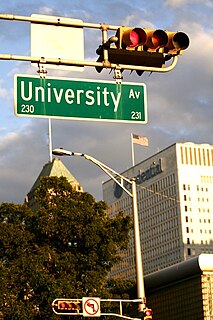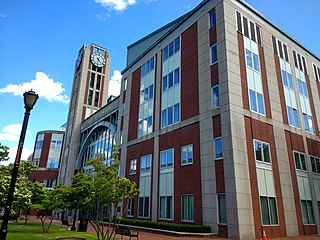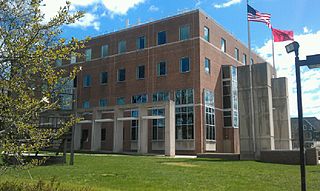Related Research Articles

Newark is the most populous city in the U.S. state of New Jersey and the seat of Essex County. As one of the nation's major air, shipping, and rail hubs, the city had a census-estimated population of 282,011 in 2019, making it the nation's 73rd-most populous municipality, after being ranked 63rd in the nation in 2000.

Rutgers University is a public land-grant research university based in New Brunswick, New Jersey. Chartered in 1766, Rutgers was originally called Queen's College, and today it is the eighth-oldest college in the United States, the second-oldest in New Jersey, and one of the nine U.S. colonial colleges that were chartered before the American War of Independence. In 1825, Queen's College was renamed Rutgers College in honor of Colonel Henry Rutgers, whose substantial gift to the school had stabilized its finances during a period of uncertainty. For most of its existence, Rutgers was a private liberal arts college but it has evolved into a coeducational public research university after being designated The State University of New Jersey by the New Jersey Legislature via laws enacted in 1945 and 1956.

New Jersey Institute of Technology (NJIT) is a public research university in Newark, New Jersey. Founded in 1881 with the support of local industrialists and inventors especially Edward Weston, NJIT opened as Newark Technical School in 1885 with 88 students. The school grew into a classic engineering college – Newark College of Engineering – and then, with the addition of a School of Architecture in 1973, into a polytechnic university that now hosts five colleges and one school. As of fall 2019, the university enrolls about 11,500 students, 2,000 of whom live on campus.

Kean University is a public university in Union and Hillside, New Jersey. It is part of New Jersey's public system of higher education. Kean University is best known for its programs in the humanities and social sciences and in education, graduating the most teachers in the state of New Jersey annually.

The Newark Museum of Art, in Newark, Essex County, New Jersey, United States, is the state's largest museum. It holds major collections of American art, decorative arts, contemporary art, and arts of Asia, Africa, the Americas, and the ancient world. Its extensive collections of American art include works by Hiram Powers, Thomas Cole, John Singer Sargent, Albert Bierstadt, Frederick Church, Childe Hassam, Mary Cassatt, Edward Hopper, Georgia O'Keeffe, Joseph Stella, Tony Smith and Frank Stella.

University Heights is a neighborhood in Newark in Essex County, New Jersey, United States. It is so named because of the location of four academic institutions within its boundaries — Rutgers University, the New Jersey Institute of Technology (NJIT), the New Jersey Medical School (Rutgers), and Essex County College. In total, the schools enroll approximately 35,000 degree-seeking students.

The New Jersey Historical Society is a historical society and museum located in Newark, Essex County, New Jersey, United States. The Historical Society is housed in the former headquarters of the Essex Club. It has two floors of exhibition space, a gift shop, and a hall for lectures. The NJHS offers occasional Newark walking tours. The Society formerly published the academic journal, New Jersey History.

John Cotton Dana was an American library and museum director who sought to make these cultural institutions relevant to the daily lives of citizens. As a public librarian for forty years Dana promoted the benefits of reading, pioneered direct access to shelved materials, and innovated specialized library services of all types.

Rutgers–Newark is one of three regional campuses of Rutgers University, New Jersey's State University. It is located in Newark. Rutgers, founded in 1766 in New Brunswick, is the eighth oldest college in the United States and a member of the Association of American Universities. In 1945, the state legislature voted to make Rutgers University, then a private liberal arts college, into the state university and the following year merged the school with the former University of Newark (1936–1946), which became the Rutgers–Newark campus. Rutgers also incorporated the College of South Jersey and South Jersey Law School, in Camden, as a constituent campus of the university and renamed it Rutgers–Camden in 1950.

Rutgers University–Camden is one of three regional campuses of Rutgers University, New Jersey's public research university. It is located in Camden, New Jersey. Founded in 1929, Rutgers–Camden began as an amalgam of the South Jersey Law School and the College of South Jersey. It is the southernmost of the three regional campuses of Rutgers—the others being located in New Brunswick and Newark. It is classified among "R2: Doctoral Universities – High research activity".
The Institute of Jazz Studies (IJS) is the largest and most comprehensive library and archives of jazz and jazz-related materials in the world. It is located on the fourth floor of the John Cotton Dana Library at Rutgers University-Newark in Newark, New Jersey. The archival collection contains more than 100,000 sound recordings on CDs, LPs, EPs, 78- and 75-rpm disks, and 6,000 books. It also houses over 30 instruments used by prominent jazz musicians.
Busch Campus is one of the five sub-campuses at Rutgers University's New Brunswick/Piscataway area campus, and is located entirely within Piscataway, New Jersey, US. Academic facilities and departments centered on this campus are primarily those related to the natural sciences: physics, pharmacy, engineering, psychology, mathematics and statistics, chemistry, geology, and biology. The Rutgers Medical School was also built on this campus in 1970, but a year later was separated by the state, renamed the Robert Wood Johnson Medical School, and merge with the New Jersey Medical School and other health profession schools in Newark and New Brunswick to create the College of Medicine and Dentistry of New Jersey. Rutgers and the medical school continued to share the land and facilities on the campus in a slightly irregular arrangement. On July 1, 2013, Robert Wood Johnson Medical School was officially merged back into Rutgers University, along with most of the other schools of UMDNJ, with the exception of the UMDNJ-School of Osteopathic Medicine.

The Newark Public Library (NPL) is a public library system in Newark, New Jersey. The library offers numerous programs and events to its diverse population. With eight different locations, the Newark Public Library serves as a Statewide Reference Center. The Newark Public Library is the public library system for the city of Newark, Essex County, New Jersey, United States. Currently, the library boasts an enormous collection of both art and literature, art and history exhibits, a variety of programs for all ages, and much more.

Rutgers Law School is the law school of Rutgers University located in the U.S. state of New Jersey. It is the largest public law school in the United States by enrollment and the 10th largest overall, with each class in Rutgers Law's three-year J.D. program enrolling approximately 350 students. Founded in 1908, Rutgers offers the J.D. and foreign lawyer J.D. Rutgers has over 20,000 alumni practicing in all 50 U.S. states. In 2015, Rutgers School of Law–Newark and Rutgers School of Law–Camden were unified into a single law school with two campuses.

Vailsburg is an unincorporated community and neighborhood within the city of Newark in Essex County, New Jersey, United States. Part of the West Ward, its elevation is 280 feet (85 m). As of 2000, Vailsburg had a population of 34,348. The Vailsburg section of Newark is on a hill which closely aligns with the suburban and park areas outside it. Vailsburg includes the two smaller neighborhoods of upper Vailsburg and lower Vailsburg, both of which have Sanford Avenue as a focal point. Upper Vailsburg is closer to Maplewood and South Orange.

One Washington Park is a high rise office building located on Washington Park at 1 Washington Street in Newark, New Jersey. Among the tallest buildings in the city, it is best known as the home of Rutgers Business School and Amazon's Audible.com.
The following is a timeline of the history of the city of Newark, New Jersey, United States.

Archibald S. Alexander Library is the oldest and main university library for Rutgers University–New Brunswick. It houses an extensive humanities and social science collection and also supports the work of faculty and staff at four professional schools: the Edward J. Bloustein School of Planning and Public Policy, the Graduate School of Education, the Graduate School of Social Work, and the School of Communication and Information. In addition, Alexander supports major interdisciplinary programs in African studies, Latin American studies, medieval studies, and South Asian Studies.
Clement Alexander Price was an American historian. As the Board of Governors Distinguished Service Professor of History at Rutgers University-Newark, Price brought his study of the past to bear on contemporary social issues in his adopted hometown of Newark, New Jersey, and across the nation. He was the founding director of the Institute on Ethnicity, Culture, and the Modern Experience at Rutgers; the vice chair of President Barack Obama's Advisory Council on Historic Preservation; the chair of Obama's transition team for the National Endowment for the Humanities; a member of the Scholarly Advisory Committee of the Smithsonian's National Museum of African American History and Culture; and a trustee of the National Trust for Historic Preservation. He was appointed City of Newark Historian in early 2014. His service to New Jersey included appointments by Governors Brendan Byrne and Thomas H. Kean to the New Jersey State Council on the Arts, which he served as chair for two terms, and by Governor Christine Todd Whitman to the board of the Save Ellis Island Foundation, which he also chaired.
Edward Morris Berger was an American librarian, discographer, author, editor, historian, photographer, educator, jazz producer, and record label owner. For more than forty years, Berger was affiliated with the Institute of Jazz Studies at Rutgers University. He was also a longtime friend and business associate of the jazz instrumentalist and composer Benny Carter.
References
- ↑ "New director appointed for Dana Library, at Rutgers-Newark". Rutgers University Libraries. 27 May 2008. Retrieved 13 November 2014.
- ↑ "John Cotton Dana Library". Libraries.org. 27 January 2009.
- ↑ Edward P. Alexander (1 January 1983). Museum Masters: Their Museums and Their Influence. Rowman Altamira. p. 379. ISBN 978-0-7619-9131-1.
- ↑ Edward Berger; Henry Martin; Dan Morgenstern; Evan Spring; George Bassett (1 June 2009). Annual Review of Jazz Studies 14. Scarecrow Press. p. 221. ISBN 978-0-8108-6921-9.
- ↑ Watkins, Ann. "Institute of Jazz Studies To Receive Literary Landmarks Designation from the New Jersey Center for the Book". Rutgers-Newark. Retrieved 10 November 2014.